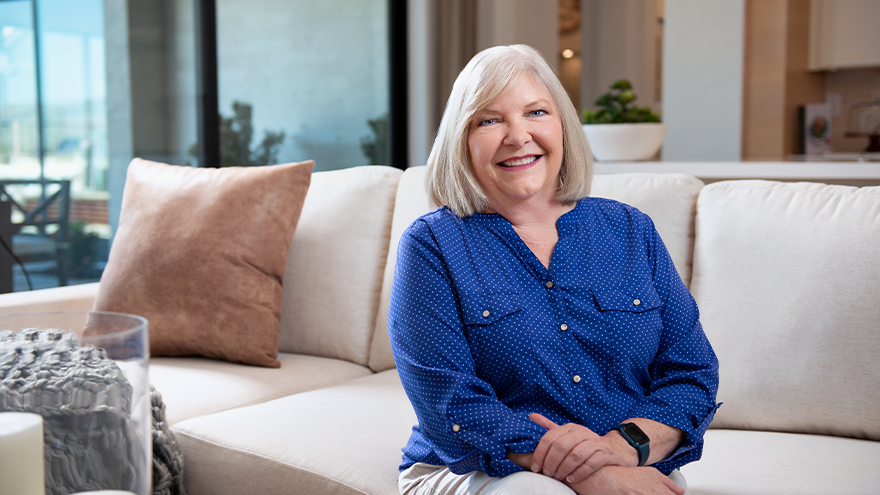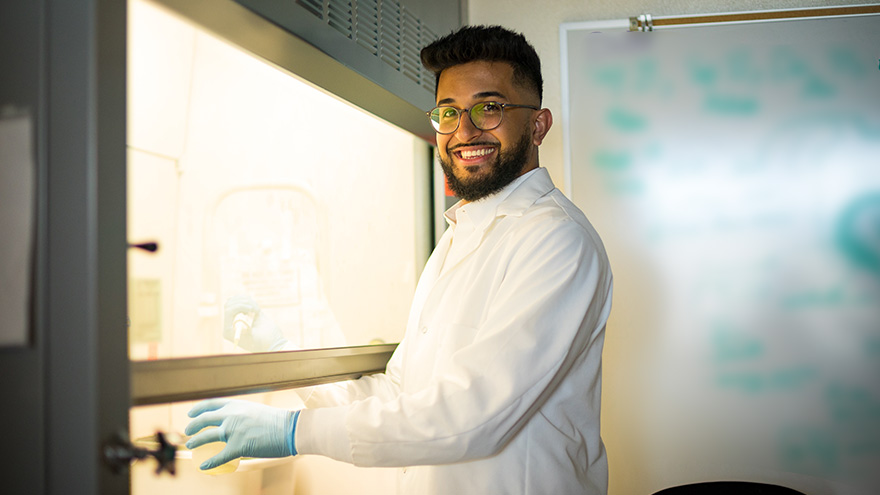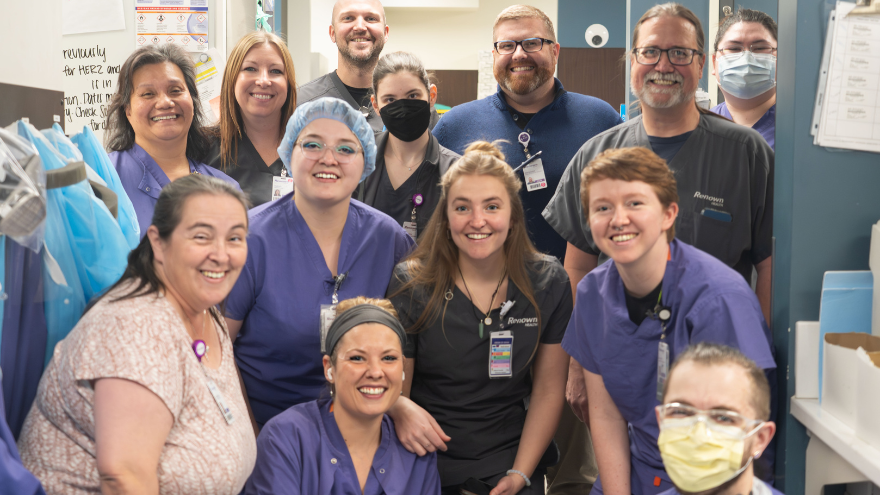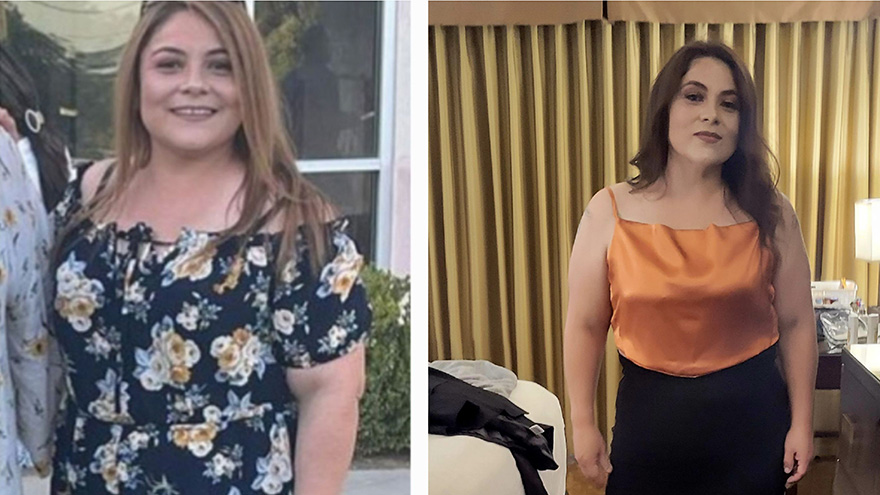Search
-
Department Spotlight: Surgery & Procedure Scheduling
When it comes to intimidating procedures such as surgery, cardiac catheterization (Cath) or interventional radiology (IR), there can be a lot of unknowns. What can I expect on the big day? What will happen after I’m all done? Will I have to worry about my orders not being in the system? Who can I call if I have any last-minute questions? It’s easy for your thoughts to race as you approach your procedure date, but luckily, there is a team who puts your mind at ease. With Renown Health’s Surgery & Procedure Scheduling department, patients can breathe a sigh of relief knowing that all the nitty-gritty is taken care of before they step foot in the procedure room. This team operates in the mindset of a complex Tetris board – fitting in all the pieces to make sure every patient is set on the path for surgery success. Consistent Contact Our Surgery & Procedure Scheduling team has a unique history. Initially operating as two separate teams, over the last year, our leaders skillfully combined the two teams together under one umbrella. That allows the now singular team to have line of sight across every surgery and Cath or IR procedure plan and be better stewards of the resources they have at their fingertips to provide streamlined, more-connected care for patients. As one might imagine, with the merger of the two teams, the day-in-the-life of each team member is full of a variety of crucial checklist items to cross off – all supporting constant communication from patients to providers. On the surgery scheduling front, these team members are resource rockstars. From working with referring providers to get patients scheduled appropriately to ensuring rooms and equipment are available for every patient, this team makes sure everything and everyone is in place when the time comes to help create a successful procedure and the best possible patient experience. “In surgery scheduling, we handle inbound calls for the outside offices to get time scheduled for each patient in the operating room (OR),” said Lydia Sharkey, Senior Scheduler. “We make sure there are plenty of anesthesia resources and equipment for every surgery, including any important information that we need to schedule patients appropriately and adding all documents to the OR board. If we need to swap rooms or move patients around, we handle that process too.” Over on the IR/Cath scheduling side of things, this team is on the frontlines of patient communication. They are experts in helping patients navigate their procedure from start (seeing their provider and obtaining the proper referrals) to finish (the day of the procedure and post-procedure process). “My day is a little different than the hospital schedulers; our part of the team handles the outpatient aspect,” said Adrienne White, Senior Scheduler. “We are in constant contact with patients and the IR and Cath departments. We help them navigate their procedure, including what to expect during and after the procedure. We get them through the process as easily as possible and ease their minds, so they know what is going to happen every step of the way. It’s all about communication, communication, communication!” This department has a significant overarching role: make sure all documents and ancillary information is set up for all our clinical teams that help with surgeries and procedures. This critical work means that every process is followed, and no important details are left out. “No one wakes up and says, ‘I want to have surgery;” our team goes above and beyond to make sure every single detail is taken care of so that when patients arrive, everything is in place,” said Trisha White. “Our team works hard to ensure everything runs as efficiently as possible because we want to use our resources in the best way possible to serve our patients without delays. We make sure we receive all the orders, codes and insurance and that the teams that follow after us – including our pre-admit team and nurses – have all the information they need to do their job seamlessly." With all the work they accomplish daily – not to mention how they wholeheartedly support each other through it all – it’s no question that the entire team has a lot to be proud of. Besides helping make patient care possible, the team puts their departmental merger and the move to fully remote work at the top of the list. “We’re most proud of merging the surgery scheduling and procedure scheduling teams together and therefore more cohesive,” said Mary Gray, Senior Scheduler. “The merger has made our team blossom and be able to connect with and rely on one another even more. We aren’t afraid to speak up and say something. At the end of the day, we’re here to take care of the patient, but we also help each other out. Our morale has gone up, and everybody is happier. Even though we all work remotely, we are more connected and have a great work-life balance.” “Along with transitioning the two teams into one big team, the move to being fully remote was huge," added Patricia Cruz-Hernandez, Surgical RN Scheduling Coordinator. “We worked through all the glitches, and it was a seamless transition to move into a remote setting. What’s great is that it did not affect patients at all; everything still gets done exactly as it should.” No matter how busy the days may get, Renown’s surgery and procedure schedulers always remember one thing: they are incredibly grateful for their fellow team members. “We have a very efficient and hard-working team of women,” said Pam Chapa Valencia, Senior Scheduler. “I could not have handpicked better people for our team,” added Trisha White. “I feel so lucky to have the team that we have.” A Renown “Why” Our Surgery and Procedure Scheduling team members all have diverse stories to tell about their road to Renown and why they’ve stayed in the department for as long as they have. Whether they’ve been with us for two years or two decades, they all share the same strong calling to care for their community. “I always wanted to help people, and my grandma was a nurse,” said Pam Chapa Valencia, Senior Scheduler. “I loved hearing her stories, and it made me want to be involved in patient care.” “I have a caring nature, and a hospital nature seemed like the right fit – I've been here for 25 years,” added Mary Gray. Several of our schedulers recognized the influence Renown has within our community and the ability to grow professionally and personally, both of which were a driving factor in their decision to make our health system their long-term career. “I’m originally from southern California, and I moved here about eight years ago; my husband always talked so positively about Renown, especially with how big it is and how it has the only level II trauma center in northern Nevada, so my goal was always to get a job here,” said Lydia Sharkey. “It’s been a great environment to be a part of.” “I’ve been with Renown for 17 years, and I chose to come here because of the reputation of the services Renown provided and care they gave,” added Trisha White. “I also knew what opportunities there were for me professionally, and in doing so, we are taking care of our community. I’ve had the chance to grow within my own professional skills and leadership skillset.” A profound feeling of ‘home’ is a common theme among this department. These team members appreciate the sense of community Renown has, the strides we’ve made in expanding our reach and how our health system gives healthcare professionals who are new to the field a chance to succeed. “At the time, Renown was the only hospital that would train nurses, and as a brand-new nurse, I had no experience – Renown took a chance on me,” said Patricia Cruz-Hernandez. “I feel like this is home. Our health system is so community-based and people-first minded, keeping ‘mission over margin.’ We’re growing, we’re expanding, we’re everywhere!” “I was a part of a transition as the cardiology private practice I worked with became a Renown practice, and it was great,” added Adrienne White. “This transition enabled us to provide more services and better care to patients. I stay here because I see the leaps and bounds we’ve been able to make in terms of procedures, accessibility and patient experience.” As true advocates for both patients and each other, the team is proud to have found their niche – and the ultimate beneficiaries? Everyone undergoing a surgery or procedure at Renown. A Culture of Kindness and Gratitude When you meet the Surgery & Procedure Scheduling team, you are greeted with warm smiles and an enthusiastic “Nice to meet you!” You can’t help but smile back and feel the infectious kindness they exude. Renown operates with a People-First mindset, a vision that this department especially takes to heart. They emulate the exact definition of our “Collaboration” cultural commitment. “We’ve built very good relationships and rapport with the OR managers and board runners,” said Lydia Sharkey. “The communication that we have at all three locations is very solid.” “The OR leadership is always so willing to help out whenever they can, and the resources they’ve provided have been huge for us,” added Adrienne White. “All the teams that see the patients after us – especially the surgical pre-admit team and the case managers, are fantastic about collaborating with us and reaching out to solve any issues they may have,” added Trisha White. “We all work so well together, especially since we all impact patient care.” In any organization, strong and compassionate leadership is key to a thriving team. Luckily for our surgery and procedure schedulers, they have Trisha White on their side. They attribute a lot of their success to having a supportive leader who “gets it.” “Trisha has been a scheduler like us, so she completely understands when we’re having an issue, because she’s struggled with the same thing and knows where we are coming from,” said Mary Gray. “It makes us feel like we are not alone – I can always reach out to her, or any of my other coworkers, to ask questions and figure out a solution together.” Despite being a remote-only team that meets in-person only one or two times a month, this group never misses an opportunity to reconnect both online and offline. They frequently shout out their Culture Ambassadors, schedulers Pam Chapa Valencia and Roxanne Abundis, for their team’s high morale. “Even though we all primarily work remotely, our in-person days are some of my favorite days of the month,” said Trisha White. “We feel so uplifted, we laugh and we have fun. We love being with each other. Pam and Roxanne are our Culture Ambassadors, and they both have been amazing at planning fun things for our teams. They go above and beyond to make our team feel cohesive and included.” “Pam and Roxanne have been leaders in creating a fun environment and supportive culture for us,” added Lydia Sharkey. “Whether it’s creating care packages or making sure we all have a good time when we see each other in person, they deserve a lot of credit.” As this team excels in their roles and foster a culture rooted in kindness and gratitude, we can trust that Renown’s surgeries and procedures will continue to thrive, and patients will continue to benefit from their diligent efforts and commitment to efficiency. “We make the magic happen!” closes Mary Gray.
Read More About Department Spotlight: Surgery & Procedure Scheduling
-
Meet Janelle Wood: Family, Hobbies & Everything In Between
Janelle Wood’s life has been filled with moves across several states, travel, different jobs, multiple hobbies and best of all – her big family. She is very close to and proud of her entire family, including her six children, six grandchildren and extended family members. New Chapters Janelle was born in 1950 in Fayetteville, Arkansas. She lived there her entire childhood and attended the University of Arkansas, Fayetteville where she received her Associate degree in Accounting. She then moved a few different times to various states including Louisiana and Arizona. In 1981, she and her family moved to Reno where she worked for a construction and mining supply company. In 1993, they relocated to a small town in southern Georgia called Thomasville, where Janelle worked for another mining and manufacturing company. “I was ready for a change of scenery and wanted to explore living in a new area,” said Janelle. “I was intrigued by moving to a smaller town to raise my children.” She and her family lived there for about 10 years when she eventually got transferred to Chicago for her job, to work at the company’s headquarters. “I was once again excited for another change and was happy to experience living in a big city,” said Janelle. “I loved my job and getting to travel as much as I did.” Janelle worked for the company in Chicago until 2014 when she decided to retire and move back to Reno to be closer to her son, daughter and grandchildren. Living to the Fullest Today, Janelle lives in Damonte Ranch in south Reno. She loves spending time outdoors, especially in the mountains and by the water. Her other hobbies include reading, cooking, doing puzzles, playing computer games antique shopping and something very unique – exploring old graveyards. “I love how they’re full of history and each one is different – I also enjoy reading what the headstones say, and the stories they tell,” said Janelle. “When I travel, I like to explore the old cemeteries that are nearby.” Janelle’s son even bought her a book called 129 Cemeteries to Visit Before You Die. She’s been to a few of them. As for traveling, Janelle’s favorite destination she’s been to is Catalina Island – she loves the history there. She also loves Chicago, Portland, Seattle, Canada and Mexico. “I’m always up for going someplace new,” said Janelle . Janelle Wood hiking to Rainbow Falls in Mammoth, CA When Christmas rolls around, Janelle loves to decorate. Her family finds it interesting just how crazy about Christmas she is. “I have 31 totes of Christmas décor and a dozen large decorations,” said Janelle. “My entire storage room is full of Christmas decorations. I start decorating the day after Thanksgiving and it takes me about 2 to 3 days to put everything up.” Janelle said Halloween is her second favorite holiday, which she also loves to decorate for. Family Values Above all else, Janelle’s favorite thing about being retired is having so much free time to spend with her children and grandchildren who live here in Reno. “I love helping my grandkids with their schoolwork and attending their sports and activities,” said Janelle. She has been volunteering at her grandchildren’s schools here in Reno ever since her now 14-year-old grandson started kindergarten. “Family is the highlight of my life,” said Janelle. She also makes sure to stay in contact and visit as often as possible with all of her family that lives out of state, including three of her children, one of her grandkids and some of her extended family. “One of my great nieces, Madison Marsh, was recently crowned Miss America, and another one of my great nieces, Madeline Bohlman, will be competing this summer for the title of Miss USA, as the current Miss Arkansas USA,” said Janelle. “I’m very proud of both of them for using their platforms to further such important issues; pancreatic cancer research and mental health, respectively.”
Read More About Meet Janelle Wood: Family, Hobbies & Everything In Between
-
Make Your Own Trail Mix: 4 Quick and Easy Recipes
Craving a crunchy, sweet, and nutritious snack? Try making your own trail mix! Perfect blends of nuts, dried fruits, and a touch of chocolate can be whipped up using bulk bin ingredients or pantry staples. Enjoy this delicious, healthy snack on a hike, at the office, or on your next road trip through Nevada's scenic deserts.
Read More About Make Your Own Trail Mix: 4 Quick and Easy Recipes
-
Why Childhood Immunizations Are So Important
Immunizations save thousands of lives each year by preventing serious illnesses, hospitalizations, and deaths. They also protect those who can't be vaccinated, like young children and the elderly, through herd immunity. Renown Pediatrician Dr. Kristin Wilson highlights the crucial role of vaccines. Immunizations Your Child Needs (and when) Birth to 6 Months Hepatitis B: Shortly after birth, first vaccine dose Diphtheria, Tetanus, and Pertussis (DTaP), Polio, Haemophilus Influenza (HiB), Pneumonia, Hepatitis B and Rotavirus: Ages 2, 4 and 6 months, boosters and vaccines One Year to 18 Months MMR and Varicella (chickenpox) vaccine: Age 1, first vaccine dose Hepatitis A, HiB and Pneumonia: Age 1, booster DTaP: 15 months, fourth vaccine dose Hepatitis, second dose: 18 months Flu Vaccine: 6 months and older, annually* *In the year after receiving their first dose, an infant will need a booster one month later. Four Years Old MMRV, DTaP and Polio, final dose: Four years of age Pre-Teen and Beyond Tdap and Meningitis: Before starting middle school, children receive these vaccines. They are also old enough to start the HPV vaccine, an essential vaccine for all young adults to protect against cancer, genital warts and cervical dysplasia.
Read More About Why Childhood Immunizations Are So Important
-
A Therapist's Tips to Prevent and Manage Osteoporosis
Want to know more about osteoporosis and osteopenia? We'll dive into these conditions and give you some handy tips on preventing future problems and taking care of your bones. What is Osteopenia? Osteopenia (low bone density) is the initial stage of bone mineral density loss, which can eventually progress to osteoporosis if steps are not taken to prevent it. What is Osteoporosis? Osteoporosis is a condition that weakens our bones. While it literally means “porous bone," it doesn’t mean that our bones are doomed to succumb to the changes that can happen to us silently over time. Our bones are living tissues that are constantly breaking down and remodeling themselves. Osteoporosis and osteopenia are typically diagnosed by testing bone mineral density using scans that your primary care provider can easily order. This is important testing because it dictates your risk of breaking a bone in common areas like your hip, wrist or spine. It also helps set the stage for talking with your healthcare team to develop a treatment plan. Most people will reach their peak bone mass in their mid to late twenties. There are several factors that increase our risk of osteoporosis or osteopenia as we age, such as menopause, genetics and other lifestyle factors. However, there are several things you can do to mitigate this breakdown and assist your body in the constant remodeling it does to our bones. 3 Controllable Factors to Build Strong Bones 1. Talk to your primary care provider They can go over a plan and prescribe things such as vitamin D, calcium and medications that can help if you are at risk or have osteoporosis or osteopenia. 2. Maintain a healthy diet Talk to a dietician if you need further help as they can be an invaluable resource to develop a plan. Eat foods rich in calcium, vitamin D and vitamin C. These assist with the rebuilding of bone. Examples include but aren’t limited to leafy greens, legumes, salmon and healthy dairy products. Don’t smoke — it directly correlates with a decrease in bone mass. Smokers also take longer to heal from a fracture. Limit alcohol to two to three beverages per week. Alcohol interferes with the production of vitamins needed to absorb calcium and the hormones that help protect bones. 3. Exercise Talk to your primary care provider to get a referral to physical therapy if you need help with exercise. Our bones adapt to the stresses we put them through. Therefore, exercise should be tailored to putting the right stress on our bones. There is good quality research that most exercise is safe when dealing with less bone mineral density. The exercises should be progressively challenging and increase the load for resistance and weight training at least two to three days a week. Examples include squats, step-ups, chest presses and rows. Exercises higher in velocity will lead to more power and bone adaptation. Examples include quicker push-ups, marching and quicker walks. Exercises that are weight-bearing will lead bones to adapt to the stress placed on them. Movements such as mini stomps, step-ups, jumping, jogging and so forth may be used depending on how your body tolerates these things to really stimulate bone adaptation. There are aspects of aging and bone health we can’t control, but we can take steps to minimize the chances of bone loss and osteoporosis. Talk to your healthcare team to determine your risk and don’t forget to show your bones a little TLC – you’re going to need them.
Read More About A Therapist's Tips to Prevent and Manage Osteoporosis
-
Why Am I So Tired? 9 Reasons for Your Chronic Exhaustion
Do you find yourself struggling to stay awake during the day or having no energy? You’re not alone. Whether you’re a full-time employee, a student or retiree, that “I’m tired” feeling comes in all shapes and sizes. What’s even more frustrating is not knowing the source of your exhaustion. Dr. Brandon Flores, a sleep medicine physician with Renown Medical Group, breaks down nine key reasons why you may be feeling so fatigued. You did not get enough sleep, or your quality of sleep is poor. This may seem obvious, but in today’s “rise and grind” culture, sleep can be considered a luxury rather than what it really is: a necessity. Ensuring you get adequate hours of sleep between 6-9 hours and quality sleep is essential. You may not be breathing well during sleep. Interruptions to your breathing, such as snoring, can decrease airflow at night causing your sleep to be less restorative. This is often due to Obstructive Sleep Apnea (OSA). OSA can lead to daytime fatigue and sleepiness and can also impact other chronic health conditions, such as hypertension, diabetes, acid reflux, migraines and heart rhythm. You are not getting enough regular exercise, or you are exercising too much. Incorporating at least 30 minutes a day of physical activity can help keep you energized throughout the day. It has also been shown to increase deep slow wave sleep, which is often associated with feeling rested. On the other hand, getting too much exercise can tire you out more easily and heighten stress levels. You drink too much caffeine. This one may seem counterintuitive – caffeine is supposed to keep you awake, right? Well, overdoing it with your favorite coffee or soda could affect your sleep quality. Pay attention to your caffeine limits and have a cut-off time, as most caffeine should not be consumed past noon. You have a food allergy or intolerance. If you find yourself feeling especially tired after eating a lot of a certain food, you could have an allergy or intolerance to it – and vice versa. Consider speaking with your primary care provider (PCP) about a food allergy test or being referred to an allergist. You’re drinking too many alcoholic beverages. Alcohol is a depressant, which as the word implies, can make you feel especially tired during the day. It can also affect your breathing at night and disrupt your sleep cycle. Cutting back on alcoholic drinks may be beneficial to your overall health. You are anemic. This is the leading cause of fatigue in women but can affect people of all genders. It can be associated with low iron. Eating foods high in iron, including leafy greens and many different meats, can help your iron levels. A blood test ordered by your PCP can help you understand if you are iron deficient. You are experiencing depression or anxiety. Emotional exhaustion can be just as taxing as physical exhaustion. Prolonged feelings of sadness, hopelessness, nervousness or panic can be signs and symptoms of depression or anxiety. Speak with your provider about the many resources available to help you. You have an underactive thyroid. Feeling fatigued can also be a symptom of hypothyroidism, which affects your metabolism and energy levels. Medication can help get your thyroid back to normal. Your PCP can order a blood test to determine your thyroid levels. If you experience severe exhaustion that lasts six months or longer, worsens after physical or mental exertion and does not get better after resting, it could be a sign of myalgic encephalomyelitis, otherwise known as chronic fatigue syndrome (CFS). This is a diagnosis of exclusion, and other causes must be ruled out. While there are no tests that detect CFS, your provider can order blood and urine tests to rule out other causes of your fatigue and help develop a care plan. © Africa Images via Canva.com
Read More About Why Am I So Tired? 9 Reasons for Your Chronic Exhaustion
-
Eight Lessons from an MD-PhD Candidate at UNR Med
Meet newly minted Dr. Majid Khan, PhD., a native of Reno, and current MD-PhD candidate and first-generation medical student at the University of Nevada, Reno School of Medicine, who is on his way to a career as a Neurosurgery. While most graduate students often choose between pursuing a medical degree (MD) or a doctorate in philosophy (PhD), Majid has boldly picked both. He is one of three medical students currently in the UNR Med MD-PhD Program run by Dr. Caroline Cobine, PhD and Dr. Violeta Mutafova-Yambolieva, MD, PhD. "Research is not merely an act of sitting at a computer and reading papers – it's about answering the thought-provoking questions about things we come across on a daily basis. By critically evaluating these ideas we can implement solutions to enhance various aspects of the medical field and patient care with an overall goal of improving patient outcomes," Majid said. Majid recognizes that modern research extends beyond academia and holds significant value for hospitals. “Research contributes to improving patient outcomes. By reviewing the data from peer-reviewed research studies, medical professionals can be better prepared to deliver effective care following the most up-to-date guidelines and data,” he said. Majid's journey to pursuing his MD-PhD with a goal of becoming a physician-scientist-surgeon began following a summer in the PathMaker Cancer Research Program at the Huntsman Cancer Institute at the University of Utah. "It was by fate that I stumbled into this field – ever since I saw my first brain surgery, I haven’t been able to look back," Majid said. Here are some of the valuable lessons that Majid has learned along the way. 1. Beyond the 9 to 5, Embrace both 5 to 9s To avoid burnout and nurture personal passions, make your time spent outside of work and school intentional. Harness any free time to reconnect with friends, pursue hobbies and engage with mentors and mentees. 2. Collaboration is Key Work collectively with colleagues locally, nationwide and even worldwide. Cultivate environments to share knowledge and innovation, as well as wisdom, which will evidently lead to more impactful outcomes. 3. Shine a Spotlight on Your Colleagues Acknowledge and celebrate your colleagues in group settings when you notice something outstanding that they’ve said or done – it could anything big or small. Shining the spotlight onto those who are making positive changes within the hospital can inspire a beautiful culture of academic healthcare, which ultimately improves patient outcomes. 4. Redefine Mentorship Mentorship does not need to be confined to traditional frameworks. Seek out guidance in unexpected and untraditional places; sometimes, the most enlightening lessons and opportunities emerge from the most unlikely sources. 5. Diversify Your Experiences Embracing a diverse range of experiences enriches one's medical acumen. You never know when a seemingly unrelated job or experience will help in a scenario in your career. 6. Live By the Mamba Mentality Follow the late Kobe Bryant’s approach to life and work, the Mamba Mentality. This includes planning long-term goals, placing meaning in everything, striving for constant personal growth, following your passions and focusing on the process rather than the end goal. 7. Make Time for Your Loved Ones Don’t forget who helped you get to where you are in your life, specifically your family, friends, teachers and mentors. By making time for the most important and loving people in your life, you will be surrounded by positivity which will help propel you to new heights. 8. Plan your Next Five Moves We all have the ability to come from nothing and become something. Take the time to plan out everything and execute your moves with careful precision. Majid has plans to return to the Biggest Little City after completing Neurological Surgery Residency Program. If you would like to get in touch with Majid, please reach out to him via email at majidk@med.unr.edu.
Read More About Eight Lessons from an MD-PhD Candidate at UNR Med
-
Department Spotlight: Pathology
Celebrate Leap Day by leaping into the world of Pathology at Renown Health! Think of discovering a diagnosis like solving a mystery: the condition is the suspect, the nurses are the frontline police force and the doctors are the lieutenants or captains finalizing the results of the case. You may notice that one crucial role is missing on this list – the detectives. In the diverse network of healthcare, the detectives are a significant part of each patient’s mystery-solving care team and represent many roles across our health system. When it comes to figuring out the elaborate details of a growth, disease, organ abnormality or cause of death, one team of detectives, quite literally, goes as deep as possible. Those detectives are the team members within Renown Pathology. For each specialized field within medicine or surgery, the Pathology department is here to play a crucial role in accurate diagnoses. With each slide examined and each test meticulously conducted in their bright laboratories, these dedicated professionals shape a path towards wellness and recovery. Meet Your Anatomy Experts Whether you have a chronic disease that needs consistent testing, a high-risk birth that requires placenta testing, a suspected cancerous tumor that needs a biopsy or a gall stone that must be removed (or anything in between), Renown’s Pathology team steps in to provide biological answers to your body’s questions. This department offers the most comprehensive in-house diagnostic testing in the region, from routine histology to full pathology. As the busiest pathology department in northern Nevada, this team boasts the fastest turnaround times from respected experts, including: Pathologists Pathology Assistants Histotechnicians Histotechnologists Clinical Lab Assistants Let’s break down the complex nature of these team members' jobs by walking through their everyday responsibilities at work! Pathologists Pathologists are medical doctors who specialize in the study and diagnosis of disease. With every slide they scrutinize and every sample they analyze, pathologists unravel the mysteries of disease with precision and compassion. Their responsibilities include interpreting laboratory tests, analyzing tissue and fluid samples (obtained from a variety of different sources, including biopsies and surgeries), staging cancer diagnoses and providing diagnostic insights that guide treatment decisions. “Our job is to help the patients and their doctors figure out what’s wrong,” said Dr. Christie Elliott, Pathologist and Medical Director of the Clinical Laboratory at Renown Regional Medical Center. “As the bulk of our cases deal with cancer, almost every day we start with a tumor board alongside fellow surgeons, oncologists, radiologists and geneticists. From there, we order extra studies, run through our cases to make diagnoses, review slides and ensure all information goes into the charts, which is especially important as 70% of data in medical charts is from the lab. A patient’s history is everything.” Pathology Assistants With the steadiest of hands, pathology assistants, also known as PAs (not to be confused with physician assistants), guide the diagnostic journey from patient specimen to diagnosis. They can typically be found processing surgical and biopsy specimens (includes accessioning, gross examination, description, and sampling for microscopic analysis), preparing tissue samples for microscopic evaluation, helping the pathologist determine a cause of death for autopsies by conducting organ dissections and maintaining detailed records of all diagnostic findings. “As a PA, I still impact patient care without being directly patient-facing,” said Andrew Whitner, Pathology Assistant. “I handle 300-350 small tissue blocks a day. During dissections, I identify landmarks, document what I see and turn those landmarks into slides, looking for things that don’t look normal.” “Our job is 90% all about gross specimens, and we also do eviscerations for autopsies,” added Leslieann Haffner, Pathology Assistant. “We are trained on what normal looks like; our goal is to find the abnormal.” Histotechnicians Histotechnicians work behind the scenes to help transform ordinary tissue into extraordinary windows of insight, revealing the inner workings of the human body. As vital members of the Pathology team, histotechnicians embed tissue specimens in paraffin wax blocks (a process that preserves the tissue's structure for examination), cut thin sections of tissue from the paraffin blocks using a microtome, mount tissue onto glass slides and stain the tissue slides using histological stains to highlight structures or cells. “With all the patient specimens we work with, we get to see a lot of organs and learn what is causing the abnormalities,” said Reiny Hitchcock, Histotechnician. “I enjoy the opportunities to expand my knowledge, especially while working alongside the doctors.” “Our job can change by the week,” added Jessica Fahrion, Histotechnician. “One week I’ll be in the grossing room, and the next week I might be training in cytology." Histotechnologists In a world where every slide holds the key to a patient's future, histotechnologists are the champions of progress. One career ladder step above histotechnicians, these team members often have a broader scope of responsibilities, including more complex laboratory procedures, developing and validating new techniques, managing laboratory operations, interpreting results and troubleshooting technical issues. You can count on histotechnologists for validating antibodies and handling orders from pathologists, oncologists, emergency physicians and more. “My day always involves looking into cases, reading reports, getting orders together and working with pathologists to help them with their diagnoses; I also work a lot with immunohistochemistry, helping out with routine slides,” said Charles Koeritz, Histotechnologist. “I especially enjoy doing validations, which help maintain the integrity of lab testing and our diagnostic processes.” Clinical Lab Assistants Our pathology clinical lab assistants are the masters at “filling in the blanks,” assisting in whatever area needs it most, especially in cytology and the grossing room. They are essential aspects of the Pathology team, collecting and storing specimens for further testing, assisting in managing test results, gathering data, managing supply inventory and more. “As a Clinical Lab Assistant, I can be scheduled anywhere, from tissue cassetting to grossing,” said Ellie Somers, Clinical Lab Assistant. “Working in cytology is one of my favorite parts of my job. It’s very rewarding to work with the doctors to uncover what treatments will help each patient. We do cytology very well here.” The Bottom Line Even though the Pathology department doesn’t always experience a lot of patient face-to-face time, they interact with patients in a different way – by uncovering the story that is the inner workings of the human body, one slide and one sample at a time. “It’s important to remember that the slide IS a patient,” said Dr. Elliott. “We are constantly learning from every case so we can continue to provide the best patient care possible.” Take a Photo Tour of the Pathology Lab!
-
What is Polycystic Ovary Syndrome (PCOS)?
Dr. Carilyn Hoffman with Renown's Women's Health explains the symptoms, causes and treatments of Polycystic Ovary Syndrome (PCOS) (also referred to as Polycystic Ovarian Disease (PCOD)), a prevalent condition among women of reproductive age that influences hormonal balance, metabolism and fertility. Make an appointment with Renown Women's Health Click here to schedule Call to schedule: 775-982-5000 PCOS Defined PCOS is a constellation of symptoms characterized by two of the three criteria: multiple small cysts on the ovaries visible via ultrasound, irregular periods and signs of hyperandrogenism. Other symptoms include infertility, insulin resistance, and increased risk of cardiovascular disease. Symptoms of PCOS The symptoms of PCOS can vary from woman to woman, but some of the most common include: Irregular menstrual cycles: This is often one of the first signs of PCOS. Women may experience fewer than nine periods a year, more than 35 days between periods, frequent spotting, and/or abnormally heavy periods. Excess androgen levels: High levels of male hormones may result in physical signs such as excess facial and body hair (hirsutism), severe acne and male-pattern baldness. Polycystic ovaries: Enlarged ovaries containing numerous small cysts can be detected via ultrasound. Causes and Risk Factors The exact cause of PCOS is unknown, but several factors may play a role: Genetic predisposition: A family history of PCOS increases the risk. Insulin resistance: High insulin levels might increase androgen production, causing difficulty with ovulation. Obesity: Women with elevated BMI’s are more likely to have PCOS, although 20% of women with PCOS are not obese. Diagnosis and Treatment Dr. Hoffman outlines that diagnosing PCOS requires a medical history review, a physical exam, blood work and an ultrasound to evaluate the ovaries. Treatment options can range from lifestyle modifications, like diet and exercise and weight loss, to medications for menstrual regulation, fertility assistance, and rarely surgery. Lifestyle Changes A healthy lifestyle is a cornerstone of managing PCOS. Regular exercise, a nutritious diet, and weight management can help reduce symptoms and the risk of long-term health issues. In overweight patients, weight loss as little as 5% has been shown to improve symptoms of PCOS. Medication Medications may include hormonal contraceptives to regulate menstrual cycles, anti-androgens to reduce hair growth and acne, and Metformin to address insulin resistance. Fertility Treatment For women with PCOS who are trying to conceive, ovulation induction with clomiphene or letrozole is sometimes necessary. Sometimes a referral to a reproductive endocrinologist and infertility specialist is needed for more advanced technologies like IVF. Health Implications PCOS is not just about cystic ovaries or irregular periods; it can have profound implications on a woman's overall health. Women with PCOS are at an increased risk for several conditions, including type 2 diabetes, high blood pressure, heart disease, and endometrial cancer.
-
Most Common Reasons Women Visit the ER
If you or someone you know is experiencing a medical emergency, it's essential to seek immediate attention by calling 9-1-1 or visiting the ER for a thorough evaluation by a trained medical professional and timely intervention. Access to a convenient and trusted emergency room (ER) is critical to any person’s healthcare needs, including medical emergencies related to women’s health. We explored some common scenarios and warning signs prompting women to seek immediate medical attention with Aiden Gould, Board-Certified Emergency Physician at Renown Health. When your medical emergency can’t wait, Renown ER is here to provide you with the region’s leading emergency care to diagnose and treat your condition or illness. Understanding Common Reasons Women Visit the Emergency Room Gynecological Emergencies: One of the most common reasons women may seek emergency care is due to gynecological emergencies such as severe pelvic pain, abnormal bleeding or complications related to pregnancy. These issues can be alarming and warrant immediate medical attention if the issue persists or is out of the ordinary for you. Emotional and Physical Well-Being: For those facing diverse medical or mental health emergencies, seeking prompt assistance is crucial for a thorough assessment and safe, timely intervention. Renown ER teams are equipped with trained professionals who provide compassionate care for individuals seeking help in the following situations: Suicide risk assessment and intervention Substance abuse assessment Assault and trauma care Crisis support and intervention Resources for ongoing care and well-being support Severe Abdominal Pain: Unexplained and severe abdominal pain that is substantially different than what is normal for you is a symptom you should never ignore as it can indicate underlying issues. Warning signs of an acute medical situation include fever, vomiting or a rapid change in motor function and inability to move due to pain. Respiratory Distress: Difficulty breathing, persistent coughing and other respiratory issues can be especially concerning. Women with pre-existing respiratory conditions like asthma or those experiencing sudden respiratory distress should seek immediate care from a medical professional. Warning signs of respiratory distress may include a significant change in one’s breathing rate, changing of the skin color to blue, gray or paleness due to lack of oxygen, nose flaring and chest retractions. Cardiovascular Emergencies: Heart-related issues are not exclusive to men. Women can also experience cardiovascular emergencies that often go undiagnosed because symptoms differ from men. Symptoms like chest pain, extreme fatigue, vomiting or pain in the abdomen, shortness of breath or palpitations should be evaluated by an emergency medical professional as timely intervention is critical in such cases. Renown leads the region in cardiology care with our technological expertise and patient-centered approach. Our comprehensive team diagnoses heart disease and other cardiac conditions, offering personalized treatment plans. Neurological Symptoms: Sudden and severe headaches, seizures or other neurological symptoms may prompt women to visit the ER if symptoms are extremely disorientating or debilitating. These symptoms could be indicative of various conditions from mild to severe, including strokes or neurological disorders that require prompt evaluation. Renown Regional Medical Center is a Comprehensive Stroke Center, providing primary stroke care including evaluation, treatment and education to patients who arrive at a Renown facility with the signs and symptoms of a stroke. Compassionate Care in Times of Need At Renown Health, we understand that your time is valuable, especially in emergency situations. That's why we strive to provide patients with exceptional care, compassion and respect. Plan ahead and make informed decisions about seeking medical care by viewing your estimated triage wait time at a Renown ER.
-
Celebrating Resilience: Raquel's Remarkable Journey Through Breast Cancer Treatment
Raquel was 33 when she was diagnosed with breast cancer. It was April 2023, when she found a lump in her breast and was referred to the William N. Pennington Cancer Institute. After comprehensive imaging, she was diagnosed with invasive lobular carcinoma, which is a type of breast cancer that begins in the milk-producing glands of the breast. Between June 2023 and January 2024, she received a total mastectomy, chemotherapy and radiation at Renown Health. “Breast cancer is uncommon in women under 40, but any woman with a mass or lump in her breast should have an exam by a physician and imaging at any age,” said Dr. Lee Schwartzberg. In fact, according to the Centers for Disease Control and Prevention (CDC), only 9% of all new cases of breast cancer in the U.S. are found in women younger than 45. “It was a pretty scary diagnosis, but I’ve been led by great people through the process,” she said. “They were so helpful and there for me throughout the chemo and radiation.” Raquel's journey through breast cancer treatment at the William N. Pennington Cancer Institute was marked by the exceptional care provided by the Renown Health team, including nurses, nurse navigators, therapists, support teams and providers. Among the dedicated professionals, Dr. Michelle Chu and Dr. Lee Schwartzberg played pivotal roles in Raquel's diagnosis and subsequent treatment plan. Their expertise, compassion and commitment to patient care left an indelible impact on Raquel's experience. Their thorough examination and comprehensive approach ensured that Racquel received the best possible care for her invasive lobular carcinoma. In addition to the care provided at Renown, Raquel greatly benefitted from being connected with a mentor by Dr. Chu. This mentor, Kayla, had undergone a similar diagnosis and treatment plan, and at the same age Raquel. They texted and called each other throughout Raquel’s treatment, providing additional support through a challenging time. As of January 2024, Raquel is done with her treatment and continues to see her care team for follow-up appointments. “I’m through the worst and ready to rebuild my life,” Raquel said. To help celebrate this milestone, Nevada Athletics invited Raquel to receive the game ball at a Nevada Men’s Basketball game. She was joined on the basketball court for this special recognition by her husband, Raul; mother, Arlene; and two daughters, Ryleigh and Rhiannon. Racquel's journey is not only a testament to her resilience but also a tribute to the invaluable contributions of Dr. Chu and Dr. Schwartzberg in guiding her towards triumph over breast cancer.
Read More About Celebrating Resilience: Raquel's Remarkable Journey Through Breast Cancer Treatment
-
A Transformative Journey: Mary's Bariatric Surgery Story at Renown Health
Embarking on the path to bariatric surgery is a unique and deeply personal journey. Individuals like Mary Escobar choose this life-changing route for reasons ranging from improved cardiovascular health to managing diabetes or finding relief from various health complications. In Mary's case, her two-decade-long healthcare journey not only underscores the challenges she faced but also highlights the support and expertise that ultimately led to her successful transformation through bariatric surgery. Mary's Resilience: December 2002 through February 2003 More than two decades ago, Mary experienced unforeseen health complications just days after giving birth via c-section. Septic shock, hemolytic uremic syndrome, thrombocytopenia, renal failure and a blood clot in her lung plunged her into a critical state. Intensive care, plasma exchange and a long recovery followed. After being discharged with compromised kidney function, Mary faced complete renal failure two years later, leading to dialysis and a spot on the donor list. Mary's brother, a perfect match, selflessly donated his kidney on Dec. 14, 2007, marking a turning point in Mary's health. However, the post-transplant period brought new challenges, including diabetes, high blood pressure and a significant weight gain, reaching 230 pounds. Determined to regain control, Mary explored various diets without success until she consulted with a bariatric doctor. Journey to Bariatric Surgery: November 2009 - April 2021 In November 2009, Mary opted for a gastric band, shedding 40 pounds within a year. Despite initial success, issues with the gastric band arose, prompting a consultation with Dr. John Ganser at Renown Health in April 2021. Together, they decided to transition to a gastric sleeve, with comprehensive education provided to ensure long-term success.
Read More About A Transformative Journey: Mary's Bariatric Surgery Story at Renown Health











